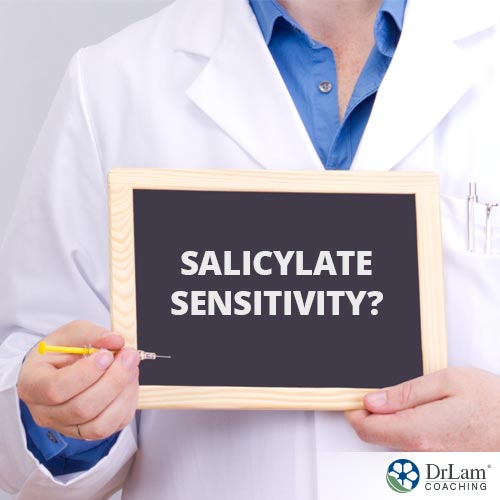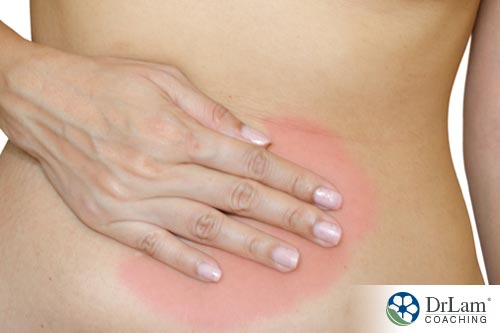 The connection between salicylate sensitivity and Adrenal Fatigue Syndrome gains clarity daily. Both consist of a lot of nonspecific symptoms that can become debilitating. Neither is well understood by conventionally trained physicians and thus are not always handled well by the medical establishment. Both are at the foundations of significant illnesses but most physicians do not consider them when assessing or addressing the illnesses they can cause.
The connection between salicylate sensitivity and Adrenal Fatigue Syndrome gains clarity daily. Both consist of a lot of nonspecific symptoms that can become debilitating. Neither is well understood by conventionally trained physicians and thus are not always handled well by the medical establishment. Both are at the foundations of significant illnesses but most physicians do not consider them when assessing or addressing the illnesses they can cause.
As we discuss salicylate sensitivity, what it is, what causes it, and its symptoms, the similarities with adrenal fatigue will make themselves clear.
Salicylates are a type of phenol found naturally in plants. The purpose of salicylates there is to act as a natural hormone and preservative. Salicylates are in all kinds of plants, so it’s very difficult to avoid consuming them. They protect the plants from bacteria, fungi, and insects. Salicylates are stored in the roots, bark, leaves, and seeds of plants. They are found in many foods and can be eaten by humans. This is unfortunate because allergic reactions to phenols are not uncommon, especially in this stress-filled society in which we live.
In large amounts, salicylates are poisonous. Much lesser amounts consumed in foods you eat can lead to salicylate sensitivities. Salicylate sensitivity will begin showing symptoms anywhere from twenty minutes to two hours after ingesting food with these phenols in it. Phenols and salicylates can easily penetrate the blood-brain barrier due to the ratio of fat to water in the cell membranes. This ability to penetrate the barrier is the reason sensitivities to phenols or salicylates can occur so quickly.
Higher amounts are found in raw or dried foods and in fruit juices. When these same foods are cooked, the level of salicylates is lower.
Salicylates are also found in products other than food. They are one of the main ingredients in aspirin and other pain medications, as well as cosmetics and beauty products. Flavored products like sweets, toothpaste, and chewing gum also contain salicylates, possibly leading to sensitivity. Artificial coloring and flavoring can also contain salicylates.
Salicylic acid is readily absorbed through contact with your skin as well. This is one reason people with salicylate sensitivities should avoid cosmetics and other products containing them. Exposure to enough of these products could quickly lead to a toxic amount getting into your body.
Of equal importance is the fact that salicylic acid is a micronutrient useful to your body. Research isn’t clear how much is needed by your body, or whether the source of the salicylic acid getting into your body is important. Its essential quality may even classify it as a vitamin.
Aside from its role as a micronutrient, salicylic acid also appears to play a role in the development of some chronic conditions such as Adrenal Fatigue Syndrome (AFS). Omega 3 fatty acids and possibly zinc appear to have some effect on the severity of symptoms of salicylate sensitivity as well.
This involvement shows a strong correlation between the severity of symptoms and other health disorders, such as inflammation, leaky gut, stress, insulin sensitivity, and deficiencies in micronutrients.
Sensitivity to salicylates is the body’s inability to deal with more than a certain amount of the substance at any given time. People with this sensitivity may not be able to eat some fruits or vegetables or handle some products.
The apparent mechanism behind salicylate activity is called cyclooxygenase, which is the inhibition of the action of two enzymes. The enzymes involved normally convert an essential fatty acid, arachidonic acid, into prostaglandins and leukotrienes.
When the production of prostaglandins is hampered, more leukotrienes are produced. This can lead to problems in people who are sensitive to leukotrienes. Leukotrienes have been linked to a wide range of inflammatory conditions.
Chronic sensitivity to salicylates is reported to be an unrecognized but common source of health problems, especially for the elderly and those who are weak. This is due to the wide variety of symptoms and the fact that they tend to be nonspecific.
Research shows many people with chronic health conditions may be sensitive to salicylates to some degree. Possibly as many as 20 percent of adults with asthma, 60 percent of people with food allergies, 70 percent of people with irritable bowel syndrome, and 75 percent of children with behavioral problems may actually be showing signs of this kind of sensitivity.
Sensitivity varies greatly among people; the severity and who or when they will be affected can’t be predicted accurately. Salicylate sensitivity may play a major role in many gastrointestinal disorders. There is also a very strong relationship between this sensitivity and asthma, which is one reason why care must be used when prescribing aspirin and other NSAIDs for asthmatics. It is also strongly linked to inflammation since Omega 3 fatty acids in high doses decrease symptoms dramatically.
Symptoms associated with this condition vary and are relatively nonspecific. Many of them are similar or the same as those found with AFS. The severity of symptoms varies from person to person. Some people may experience only one of the possible symptoms, while other may have several of them.
Physical symptoms include:

Mental symptoms include:
This is not a comprehensive list of possible symptoms, but it does give you an idea of what can occur with sensitivity to salicylates. You can also easily see the similarities between this sensitivity and AFS.
The symptoms of AFS develop slowly and without you realizing they are there. They are the result of your body’s normal response to stress. This response begins with activation of the hypothalamic-pituitary-adrenal (HPA) hormonal axis.
The adrenal glands are the organs on top of your kidneys that fight the effects of stress by secreting cortisol, the hormone that deals with stress. If stress continues unabated, the adrenals continue secreting cortisol until adrenal exhaustion takes place.
It is then that the nonspecific symptoms begin. Some of those symptoms include:
Not everyone will have all of these symptoms. Some may have only one, while others may have several of the symptoms. The more advanced the AFS, the more likely it is that you will develop these symptoms.
Symptoms of both AFS and salicylate sensitivity are often overlooked or missed by physicians who are conventionally trained. These physicians typically deal with symptoms only or with individual organs rather than addressing the root causes of AFS.
In the NEM model, practitioners assess and address how the interrelationship among organ systems may be the cause of your symptoms on a holistic basis. This is a more comprehensive approach to diseases and their remediation.
The NEM viewpoint says six organ systems called circuits typically interact with each other. Whatever affects one of these systems affects others. In the case of salicylate sensitivity, the metabolic system is affected. Specifically, the inflammation and the detoxification circuit is dysregulated. Additional associated symptoms can include chemical sensitivity, liver congestion, paradoxical reactions, leaky gut, food sensitivities, irritable bowel, and pain of unknown origin leading to fatigue, sexual irregularities, and low thyroid function.
 When you have a sensitivity, allergy, or intolerance to foods or food ingredients, it may take hours or even days to manifest symptoms. By the time these symptoms show up, you may not remember even eating the food that brought on the symptoms. But your adrenal glands feel the stress from your sensitivity, allergy, or intolerance quickly.
When you have a sensitivity, allergy, or intolerance to foods or food ingredients, it may take hours or even days to manifest symptoms. By the time these symptoms show up, you may not remember even eating the food that brought on the symptoms. But your adrenal glands feel the stress from your sensitivity, allergy, or intolerance quickly.
Thus, sensitivity to salicylates or other food products can be viewed as a hidden source of stress. Since your body responds to stress from any source the same way, that is, through activation of the HPA axis, your adrenals begin the process of dealing with this stress by secreting cortisol.
When you’re continually introducing salicylates into your body, you keep your adrenals burdened and continually working to respond. You may not even know what food you ate that started this flood of problems.
With all of the possible symptoms caused by this sensitivity and their nonspecific nature, you may not realize what you’re feeling was caused by something you ate several days ago. If you should happen to figure out your symptoms were brought on by eating something, you will probably think you ate something different than your usual foods.
You may never suspect something you eat all the time made you so sick. It is also possible that you may have a negative response to a combination of foods that you wouldn’t have any reaction to if you ate them individually.
If you have sensitivities to several foods, the lining of your gut becomes inflamed and irritated. If you continue eating foods to which you’re sensitive (or those that are irritating by themselves), your stomach lining never has a chance to heal or recover. This will lead to continuing stomach problems, possibly even to leaky gut.
If you develop this syndrome, the lining of your gut will develop weak spots, allowing partially digested food, bacteria, yeasts, and fats to travel through, or leak, into your bloodstream. This sets up perfect conditions for your immune system to react to these “foreign” products and inflammation begins. This is an autoimmune response that triggers the release of cortisol to fight the inflammation. Your sensitivities also trigger histamines that cause inflammation, thus adding to the overall level of inflammation in your body.
 By constantly consuming foods that lead to this inflammatory response, you are putting pressure on your adrenals to supply cortisol to fight it because cortisol is the body’s main anti-inflammatory hormone. If your sensitivity is to some food, such as wheat, that is a part of almost every meal in some form, you are exposing your body to this process all the time. Doing so will almost certainly lead to adrenal fatigue.
By constantly consuming foods that lead to this inflammatory response, you are putting pressure on your adrenals to supply cortisol to fight it because cortisol is the body’s main anti-inflammatory hormone. If your sensitivity is to some food, such as wheat, that is a part of almost every meal in some form, you are exposing your body to this process all the time. Doing so will almost certainly lead to adrenal fatigue.
Since salicylates are everywhere, if you are sensitive to them, you have a major problem. You may be able to control your diet and limit exposure to salicylates through food, but you also can absorb them through your skin or nasal passages by breathing in a multitude of scents.
Research and clinical practice have shown foods can affect people with chronic fatigue syndrome and lead to many of the symptoms they experience. It’s not always easy to recognize their contribution, but they can lead to any of the symptoms that show up with chronic fatigue.
Food sensitivities will typically interfere with your daily activities in addition to causing a tremendous burden on your adrenals. This makes it imperative that you find out the foods that bring on your sensitivities, avoid them as completely as you can, and lessen the load on your adrenals and improve your overall health.
 In a normal body, metabolism of phenols and salicylates poses no problem. Normal bodies have sufficient levels of sulfates and liver enzymes to detox the body of these substances. The normal body will use what it needs of these phenols, then expel the rest. But in cases where adrenal fatigue has become a problem, leaky gut due to metabolic issues can lead to salicylate sensitivity quickly.
In a normal body, metabolism of phenols and salicylates poses no problem. Normal bodies have sufficient levels of sulfates and liver enzymes to detox the body of these substances. The normal body will use what it needs of these phenols, then expel the rest. But in cases where adrenal fatigue has become a problem, leaky gut due to metabolic issues can lead to salicylate sensitivity quickly.
Leaky gut occurs when the small intestine is too damaged to properly protect the gut, allowing food particles, bacteria, and toxins to enter the bloodstream. This occurrence will trigger an immune response and inflammation. Due to the presence of phenols/salicylates in large numbers of plants, people with leaky gut will have higher than normal levels of these substances in their bodies, leading to sensitivities.
In addition to being present naturally in plants, phenols/salicylates are present in many additives and preservatives. They may actually be present in many foods without any requirement for listing them on product content labels. For example, the lining of many cereal products is sprayed with phenol-containing substances. They do not have to list this because it is not directly a part of the food.
These substances are also found in non-food products like toothpaste, hair dyes, and medications.
In order for the body to metabolize phenols/salicylates, an enzyme called phenol sulfotransferase (PST) is needed. This PST pathway is necessary to detox the body of phenols. It converts Sulphur to sulfates that then will attach to toxins to enable them to be expelled from the body. If sulfates are not produced, a buildup of toxins will occur. This leads to more salicylate sensitivity.
In this case, the hormone adrenaline, or epinephrine, won’t be metabolized. This puts more strain on the body and can lead to adrenal fatigue. The same difficulty will be seen with neurotransmitters that can build up in the brain and lead to depression, as well as other mental problems.
The best way to remedy any problems that may arise with sensitivities to phenols/salicylates is through the NeuroEndoMetabolic approach to stress responses. The inflammation and detoxification circuits will be most affected by these sensitivities. With the emphasis of this viewpoint on organ systems interacting, what affects one will affect others, as well. This gives healthcare professionals an approach that targets the root causes of illness conditions.
Making significant changes in your diet is the best way to deal with this kind of sensitivity. With the pervasive nature of salicylates, you will have to try several dietary changes until you find a diet that doesn’t bring on symptoms.
A first step could be to eliminate sugars, dairy products, and gluten to see how you feel. Cutting out these common triggers for food sensitivities for 30 days will give you a good idea if you’re on the right track.
Some people even respond with symptoms to healthy foods like nuts, seafood, and eggs. You may want to try food allergy testing if you have sensitivities to these foods. Especially if you have gut-related symptoms, “brain fog”, skin problems, or headaches. All of these symptoms can be caused by food allergies.
Histamines are often the cause of inflammation that results from sensitivities to salicylates. Some people are intolerant to histamines. Diets like Paleo diets contain foods high in histamines. These may not be tolerated well by people who are sensitive to salicylates because of the propensity of the release of histamines that cause inflammation. If you have high histamine, you may experience fatigue, anxiety, and mental fatigue.
 You should consult with your healthcare practitioner before putting yourself on a diet low in histamines or salicylates. An anti-histamine diet may be helpful, but it often has to be adjusted to fit the individual. You should always consult this professional before deciding you have this kind of sensitivity. Never make this decision by yourself.
You should consult with your healthcare practitioner before putting yourself on a diet low in histamines or salicylates. An anti-histamine diet may be helpful, but it often has to be adjusted to fit the individual. You should always consult this professional before deciding you have this kind of sensitivity. Never make this decision by yourself.
As mentioned before, if you attempt this elimination diet, you should keep it up for at least 30 days. Then see how you feel. Once the salicylates are out of your body, you should feel a difference. However, just as everyone has a different constellation of symptoms with this sensitivity, everyone responds in a different amount of time to getting these foods out of their system.
When the salicylates are out of your system and you’re feeling better, begin re-introducing foods with salicylates to your diet one at a time. Start with those low in salicylates, move to those that have moderate amounts, and then on to ones with higher amounts. Monitor yourself closely.
If symptoms return, go back to a diet with no salicylates and give your body time to heal. Keep a record of the foods you re-introduce. This way, you begin to build a diet you can tolerate well and an amount of those foods you can handle.
You must be careful when re-introducing foods with salicylates. Do this slowly and in smaller amounts. If you don’t, you can trigger a cascade of symptoms that may become severe. There is a possibility of an anaphylactic response, as is seen in other severe allergic reactions. This can lead to anaphylactic shock and even death.
Some research with capsaicin strongly suggests this substance can be effective in dealing with salicylate sensitivity. Capsaicin is the ingredient in chili peppers that give them their characteristic hot flavor. It and salicylates compete with each other for access to the nervous system receptor called TRPV1.
The ingestion of capsaicin shortly before eating salicylates reduces the bioavailability of salicylates in the blood stream. Continuing to ingest capsaicin leads to a further reduction of the levels of salicylates. The effects of capsaicin appear to last only two to three hours and must be eaten just prior to eating foods with salicylates.
In addition to avoiding foods containing salicylates, it’s also important to avoid products such as cosmetics and other products with fragrances if you’re sensitive to salicylates. This can prove very difficult because many of the products used daily contain salicylates.
An associated problem is the development of Multiple Chemical Sensitivities (MCS). Many people with salicylate sensitivity also develop MCS due to the prevalence of salicylates in the environment. MCS is sensitivity to non-food chemicals. These reactions can be very severe. The person doesn’t have to come in physical contact with these chemicals for a response to be triggered. Paints, perfumes, carpets, plastics, and cleaning products are some of the things that can trigger responses in people with MCS.
For people with salicylate sensitivity who develop MCS, the potential problems multiply. It is best for you to avoid products and foods with salicylates, fragrances, or chemicals so you can avoid reactions.
People with sensitivities to salicylates often also are intolerant of amines. The symptoms of amine intolerance are very similar to those in salicylate intolerance. This can make the two sensitivities difficult to differentiate. These amines occur during protein breakdown and the fermentation of some foods and drinks. Amines are present in fermented products like alcohol and some cheeses.
 Overcooked meats or meats that aren’t fresh also are high in amines. Remediating this sensitivity requires you to eliminate these kinds of foods from your diet. About 70 percent of the foods containing salicylates also contain amines.
Overcooked meats or meats that aren’t fresh also are high in amines. Remediating this sensitivity requires you to eliminate these kinds of foods from your diet. About 70 percent of the foods containing salicylates also contain amines.
Around 40 percent of children’s behavior problems may be due to amine sensitivity. A higher percentage of these problems have been associated with salicylate sensitivity. With salicylates, these behavior problems appear to be more silliness and hyperactivity; with amines, the behavior turns aggressive. Some clinicians have seen many children asked to leave daycare centers due to aggressiveness to be sensitive to amines.
The kind and severity of symptoms experienced with amine sensitivity depend on how much is consumed. These symptoms typically appear when the enzymes responsible for breaking down histamines are either saturated or used up completely.
As with salicylate sensitivity, removing foods containing amines is the best way to avoid this sensitivity and the symptoms that accompany it. Also just as with salicylates, any dietary attempt at remediation of amine sensitivity should be carried out under the guidance of a healthcare professional. The reason for this is the wide range of foods containing amines and the variability of tolerance levels among individuals.
Foods that can contain amines include citrus foods, papaya, strawberries, pineapples, some nuts, tomatoes, spinach, and chocolate. Animal sources include fish, crustaceans, pork, and egg whites. Other sources include additives, licorice, herbs, and spices.
Some possible ways to reduce or even eliminate some of the symptoms of a reaction to amine sensitivity include mast cell stabilizers, such as cromoglycate or ketotifen, may bring longer-term symptom relief and could allow a less restrictive diet. Antihistamines may bring immediate relief of symptoms.
 The use of vitamin B6 and vitamin C in large doses may help with symptoms of amine sensitivity, also. Some spices, such as curcumin and garlic, reduce the formation of biogenic amines in food.
The use of vitamin B6 and vitamin C in large doses may help with symptoms of amine sensitivity, also. Some spices, such as curcumin and garlic, reduce the formation of biogenic amines in food.
Always consult with your healthcare provider before taking supplements. Large doses of vitamin B6 has been shown to cause some neurological disorders. If you’re pregnant or breastfeeding, be sure to talk with your doctor before taking B6. You may experience sleepiness, upset stomach, and sensitivity to sunlight with this supplement.
Vitamin C should not be taken without care. Consult with your physician before taking this supplement if you’re pregnant or breastfeeding. You may experience headaches, flushing or redness of the skin, nausea, vomiting, and upset stomach.
Salicylate sensitivity is a type of allergic reaction to foods containing salicylates. Raw fruits and vegetables are high in salicylates. You will have many nonspecific responses that can lead to serious chronic health conditions. A diet restricting foods with salicylates is the best option for remediating this sensitivity.